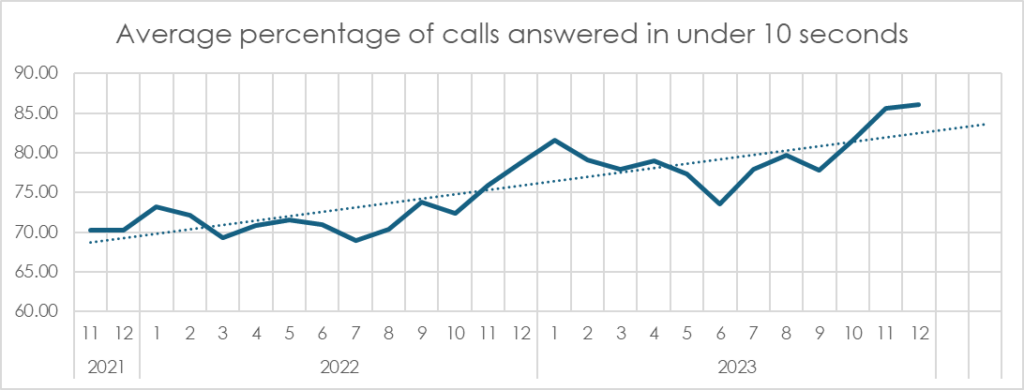Does data have the power to drive better policing?

key fact
Data is crucial to policing on 999 calls as it enables intelligence-led preventative policing and investigation, meeting citizen expectations regarding data handling, and ensuring operational efficiency.
The National Digital Policing Strategy 2020 – 2030 places digital, data and technology (DD&T) transformation at the heart of policing in the information age. Delivering that transformation at scale and pace is, according to the strategy, “central to our 2030 digital policing ambition to drive improvements in data, technology and, most importantly, the skills of the people that lead, manage and use it.” Data, in particular, is identified as being the “lifeblood of policing…enabling intelligence-led preventative policing and investigation, while continuing to meet citizen expectations regarding how we handle their data.”
The same strategy acknowledges the importance of balancing transformation initiatives across local frontline capabilities and nationally scaled delivery. 43 territorial police forces operate across England and Wales, each with their own control rooms. In this context, a certain degree of force-by-force IT change autonomy is beneficial. It allows for intelligent, cost-effective, and pragmatic prioritisation that equips each force to deal with its own regional challenges as well as aligning to UK-wide directives. But, when it comes to measuring outputs against targets, the potential for discrepancies in how the data is analysed locally versus nationally can be problematic.
A prime example of this can be seen in the case of published data for 999 calls answered within the government’s target of ten seconds. First made public in May 2022, 999 league tables will, according to the UK government, “reconnect the police with the public, holding individual forces to account and helping identify previously unknown issues, with the goal of driving up performance.” Nobody could argue with this excellent intention. However, achieving this goal is more complex than simply measuring raw data against discrete targets.
Tackling data disparities for a clearer picture of emergency call answering trends
First and most pressing: is the data gathered by each force one hundred percent definitive? In the case of at least some forces, the answer is not straightforward. When making a 999 call, most members of the public will not be aware of – or, indeed, care about – the workflow between the network provider and control room that supports that process. Control rooms manage and monitor their own call answering times. But the reality is that, when data from the network provider and the force itself are compared, they do not always correlate, risking unreliable conclusions around whether targets are, in fact, being met or not. This is more significant than a simple numerical discrepancy. Adopting a data-driven approach in policing extends to the very core of operational efficiency and decision-making. Plus, with call answering targets and the corresponding statistics now in the public domain, any data discrepancies or apparent target lags render forces vulnerable to public interpretation of the statistics that may not be meaningful or fair.
It is important to stress that, just because the control room and published data does not match, this does not imply that either is wrong. Nor does it suggest a lack of performance on the part of control rooms. In fact, as a national average, currently available data shows a clear and significant improvement in both the number and speed of 999 calls answered over recent years. Nonetheless, disparities between control room and published data cannot and should not be ignored. Rather than being simply ‘incorrect’, they are rooted in variations between how control rooms and the published data is measured.
As a starting point, a more meaningful data set could be obtained if universal reference points were agreed, and this becomes challenging when we consider the multiple technology touchpoints involved in any 999 call. When, for example, do we consider a call to start and end? Is it when it is answered by the initial call handler? Or when it is delivered to force’s call handling systems and a time stamp is generated? Are failovers (where a call is automatically switched to a backup system if the primary VoIP network is interrupted) included in the data? What about abandoned calls? If such instances are not included, why not, and what impact might these scenarios have? These are questions that we have not yet fully resolved.
What’s more, when it comes to assessing the effectiveness of modern policing, complex and subjective outcomes in areas such as community engagement, sensitive case handling, effective victim care and satisfactory arrest/conviction can be overshadowed by more easily measurable statistics. This can significantly skew perceptions of what constitutes effective policing, especially in the public domain. The publicly available data does not yet encapsulate the breadth of challenges and circumstances faced by police forces. That, in turn, may drive strategic decisions to prioritise meeting targets over more nuanced, qualitative improvements. A collaborative effort is needed to fully align local control room data with nationally reported data, bridging the gap between different data analyses, and ensuring a more accurate and unified understanding of emergency call handling effectiveness.
Embracing the road ahead for 999 call answering technology
As well as considering more meaningful ways of measuring call answering data itself, we should also be thinking about technology’s wider role in supporting our forces. While current 999 league table targets aim to ensure rapid and efficient call answering, they may not fully encompass the realities of emergency call handling from both a technological and human perspective. Recognising this creates a valuable opportunity to take a fresh look at how best the people, process, technology framework can underpin the future of policing.
Behind every 999 call made and answered, multiple sophisticated systems each play their part in answering, routing, landing, and resolving the emergency. In theory, we could remove any element of that stack. In doing so, we may improve those 999 league tables further by reducing call answering time, even by a second or two. But what impact would that have on the quality of the response? Because, ultimately, a call answered does not equal an emergency dealt with. Rather than focusing purely on reducing 999 call answering times by removing digital capabilities that may add seconds, we should instead consider the potential of new technology to support our forces in providing effective policing aligned to modern challenges.
Techniques such as predictive modelling and real-time analysis can leverage raw data to streamline resource allocation with more sophistication than human judgement alone ever could. This approach might improve efficiencies in the call answering pipeline, while also potentially supporting staff welfare and performance by ensuring that control rooms are effectively resourced at all times.
Advances in Artificial Intelligence have the capacity to move the dial even further. AI-driven systems are already capable of identifying subtle patterns and correlations that human analysis might miss, allowing for more effective staffing, call distribution, and automation strategies. Additionally, capabilities such as channel shift could improve how non-emergency calls are handled, ensuring that resources are focused where they are most urgently needed, while maintaining high standards of service across all points of public contact. This could improve the 999 call answering data by eliminating irrelevant statistics that might skew targets. But, significantly, it could also increase the uptake of non-emergency services (most obviously 101), relieving pressure on 999 call answering.
These examples are the tip of the digital iceberg, but they suggest a future where police control rooms strike the optimal balance between meeting call answer time targets and delivering a quality of service to the public. Crucially, we should be mindful of how people, process, technology, and data can collectively support the roadmap towards that goal. Today’s control rooms already deploy deeply integrated technologies like mapping, resource location tracking, dynamic response planning, and automated call routing, before we even begin to mix in the digital capabilities mentioned above. Of course, many of these are fundamentally rooted in the principle of technology’s ability to learn from the available data, as in the case of AI. And so, we come full circle to the question of data accuracy and disparity. If we are looking to data to accurately inform machine learning, predictive modelling, AI, and so on, then the data measurement itself must be consistent, the analysis rigorous, and insights viewed through a mature, strategic lens. If we can reach that point, the stage is firmly set to build a future where people, process, technology, and data come together to drive the future of better policing.
Mason Advisory has extensive experience of helping the UK’s police forces to tackle their IT, digital, data and technology transformation roadmaps. Find out more about our work with the emergency services here.
If you would like to discuss your situation with one of our experienced consultants, you can make an enquiry from any page on our website, email us at contact@masonadvisory.com, or call us on +44 (0)333 301 0093.
